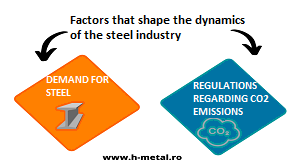2 factors that shape the dynamics of the steel industry
In the international steel industry, there are a number of factors that have a major impact on the general developments and trends in this industrial branch.
2 factors that shape the dynamics of the steel industry

1.Steel Application
Global steel demand as a whole remained constant in 2020. While the EU and North American markets saw a drop in demand of 8% and 15%, respectively, continued growth in Asia fully offset this drop in demand.
During 2021, industrial activity recovered in all markets. And, combined with low inventory levels in most value chains, apparent global steel demand rose by 6% to a new record high of around 1.875 million tonnes.
For 2022 and 2023, the outlook is very uncertain. Expectations of a continued and stable recovery from the pandemic have been shaken by the war in Ukraine and rising inflation.
The World Steel Association expects a small increase in demand in 2022. Due to the impact of the war in Ukraine, with additional downside risks due to the ongoing pandemic, especially in China, and rising interest rates.
„We expect growth to start in 2023. And that’s based on the presumption that the war in Ukraine will come to an end sometime this year. And at least at the end of this year we will start to see a recovery in the use of steel in the affected markets.” Worldsteel CEO Edwin Basson said at a press conference on April 14.
2. Environmental regulations on CO2 emissions from the international steel industry
The global steel sector is a major emitter of greenhouse gases. And therefore, it is under increased pressure in terms of decarbonization.
New customer requirements and estimated increased costs for CO2 emissions have triggered the transformation of the steel industry.
During 2021, the European Commission introduced its Fit for 55 package. It contains legislative proposals to increase the 2030 emissions reduction target. These are from 40% to at least 55%. Many industry participants are exploring new technologies – including those that use hydrogen – to meet these new requirements. This is likely to mean that more steel companies will move their blast furnace-based production to electric arc furnaces.
Innovative technological solutions are the key to achieving these goals.
<< Inapoi